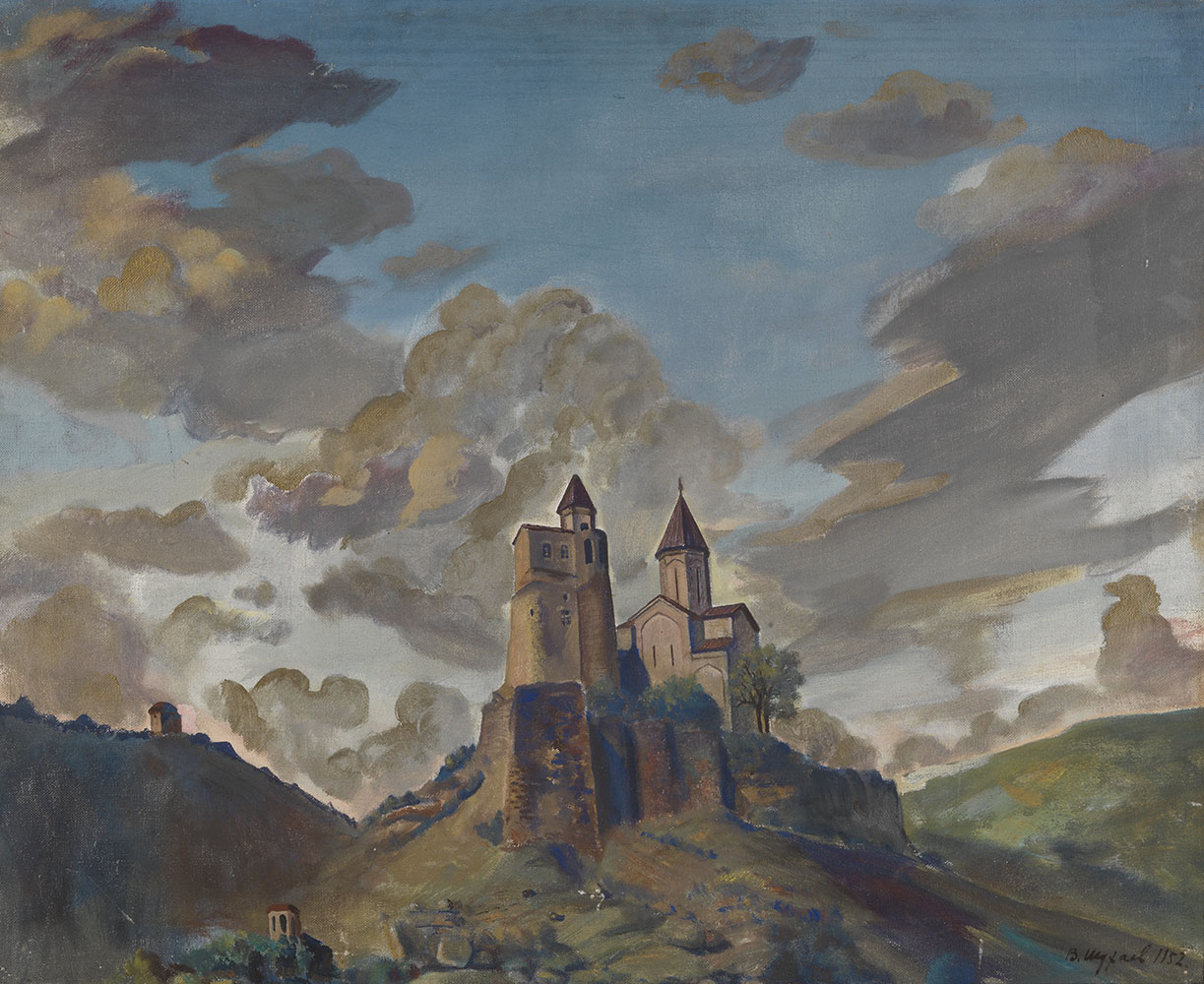MacDougall Auctions 28 November 2008
28 November 2008

* 53. SHUKHAEV, VASILY 1887-1973
Gremi signed and dated 1952
Tempera and gold on canvas, 66 by 81.5 cm.
40,000-60,000
Provenance: Private collection, USA.
Exhibited: 80th Birthday Exhibition of Vasily Shukhaev, The State Academy of Arts of USSR, Leningrad, 1968. label on stretcher.
Exhibition label of the Exhibition Hall of the Soviet Union of Artists of the USSR, No. 73, label on the stretcher.
Literature: Exhibition catalogue, 80 Year Birthday Anniversary Exhibition of Vasily Shukhaev, The State Academy of Arts of USSR, Leningrad, 1968, illustrated.
Executed in 1952, Gremi presented here for auction, marked the
start of Shukhaev’s most successful and productive period as a mature
artist. The work was completed during one of his journeys
through Georgia, some 16 kilometres outside the village of Telavi,
on the road to Kvareli. The once mighty kingdom of Kakheti fell
into decline after it was attacked by the Persian Sheikh Abbas the
Great in the 17th century. Since then, its greatness has only been
celebrated in paintings depicting the ancient ruins which so often
attracted the interest of artists. From there, a lovely view opens onto
the majestic ruins of the old Kakheti capital of Gremi. A looming
cliff supports solid fortress walls, the ruins of the Royal Palace
and the church, which was built in 1565.
Shukhaev studied embossing at the Stroganov College, where he
was trained by the outstanding masters of his day, including
Korovin and Zholtovsky. During the First World War, Shukhaev
fought at the front, and also supported the Soviets by sketching
theatre costumes and stage sets for the celebrations in Petrograd.
At the end of the War, Shukhaev travelled to Finland and Paris,
confident he was only leaving Russia for a short time… but, in
fact he only returned 15 years later. By the time he returned to
Leningrad in 1935 he had long been recognised as a serious
artist, who had successfully exhibited at various European exhibitions.
His success led the Academy to provide him with his
own studio and he was also provided with the opportunity to
teach the principles of classical art, which he so highly valued.
Two years later, however, the artist and his wife were detained
in Magadan, having been found guilty on charges of espionage.
Whilst under arrest, the artist worked on sketching stage sets for
local theatres.
He arrived in Tbilisi in 1947, and the city came to represent a
place of freedom to him. Whilst there, he was commissioned to
produce the stage layouts for Tchaikovsky’s Eugene Onegin for the
Paliashvili State Theatre of Opera and Ballet. Thanks to the patronage
of the famous artist Lanceray, Shukhaev was invited to
become a professor of Drawing at the Academy of Arts of
Georgia.
This marked a new chapter in his life. He divided his time between
working at the theatre and busying himself painting, travelling
the region extensively and painting landscapes as well as
portraits depicting cultural figures. This period developed his
easily identifiable brushwork which becomes evident in the landscape
Gremi, fluid, sweeping strokes strengthened by expressive
lines which display a careful as well as accomplished painting
technique, and light and shade are employed by strict adherence
to classical principles.
Shukhaev, like many a great artist before him, also travelled to
Italy. Here, in the Mediterranean, the Leningrad born artist, became
intrigued by the great masters of the Renaissance.
Shukhaev then looked to capture Russian architecture and to
emulate Yakovlev and Tschusev when he painted the church of
Nikolai Mirlikiysky in Bari and the Kazan Railway Station in
Moscow.
In 1962, Shukhaev was honoured by the Georgian Soviet
Socialist Republic. To further honour the artist, four exhibitions
were held between the years 1958 and 1968. The last of his solo
exhibitions, in 1968, coincided with his 80th birthday and
took place in the halls of the Academy in Leningrad.
Notes on symbols:
* Indicates 5% Import Duty Charge applies.
Ω Indicates 20% Import Duty Charge applies.
§ Indicates Artist's Resale Right applies.
† Indicates Standard VAT scheme applies, and the rate of 20% VAT will be charged on both hammer price and premium.